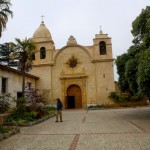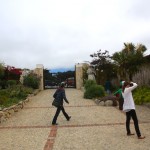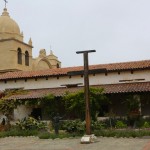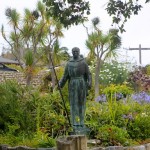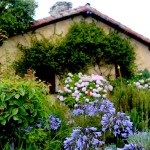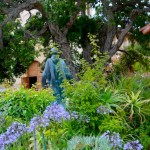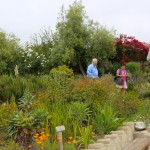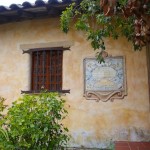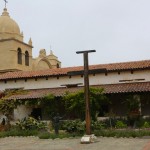 The Borromeo del Rio Carmelo Mission, Carmel.
The Borromeo del Rio Carmelo Mission, Carmel.
The Spanish settlers of 18th century California established 21 missions, from San Diego north to San Francisco. I have visited almost all of them. They are sort of the West Coast version of the old Quaker meetinghouses I loved back in PA. More often than not, the missions in SoCal seem stranded in California’s banal surrounding, shabby hamlets of deep beauty and resonance. Unlike Neuschwanstein Castle in Bavaria, or the Tower of London, the old Spanish missions rarely fit into their modern surroundings.
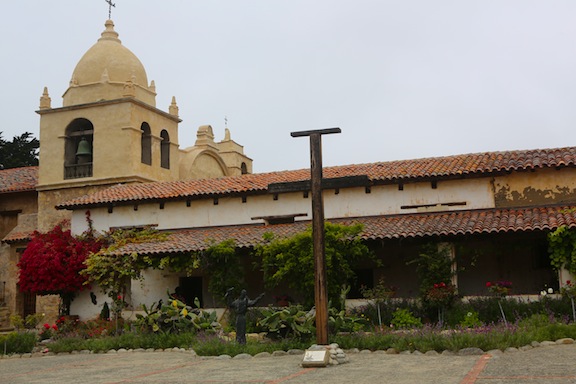
California architects, landscape artists, builders and other such scam artists usually lack the ability to successfully mesh old and new. And “New” in the American Southwest is something so uniquely grotesque. There is the Hipster Flip, or “Dwell” minimalist monstrosity; olive green or gray exterior walls, white trim and a bright, tangerine-colored door, flat, unpainted, horizontal wood slat fence. There is Tudor suburbia, Faux-Tex-Mex, and the “Beaux Arts” starter castle. Lastly, we have the signature of sprawl, the “Tuscan Villas” – faux Italianate style, tile roofs, stucco walls, shuttered windows and crenellated corners, or some derivation of the Palladian style (with sartorial historical quotation). Aggressively shoddy, cheap mini-mall quality construction, generally too big and proportioned poorly, and made of materials that are veneers, blatantly more contemporary than the image that they are constructing, with some rough hewn element tossed in, Home Depot style, oh and the stained glass windows, miles of slate countertops, lordly ceiling fans and brass fixtures that no Tuscan house ever witnessed. The Architectural Monstrosity du jour is a two-pronged emotional event: the cheapness in the rendering provokes a deep, deep sorrow while the blatant, solipsistic disregard inherent in building one’s hideous monolith right up to the property line and paving over the rest makes me want to stick forks in my eyes. All of these are so cheap and profoundly ugly, so fundamentally separate from both their natural surroundings and intended occupants. Despite all the renowned architects who made careers in California, the place still lacks a defining vernacular.
Anyway, there are exceptions to this, like Santa Barbara’s enforced Spanish Colonial Revival, the mid-century clusters of Palm Springs, and the mind-bending natural beauty of Carmel. The obvious allure of Carmel-by-the-Sea is its natural splendor. Situated on the fabled Monterey Peninsula, 125 miles south of San Francisco and hugging the coast, the town is a Disneyland version of Europe. The architecture is a fantastical mishmash of storybook English cottages, beach bungalows and Swiss Alpine chalets, sprouting from cartoonisly lush private gardens of poppies, bougainvillea, rhododendron, geraniums, hydrangea and cabbage roses. Monterey cypress and eucalyptus trees shroud the streets and masses of night blooming jasmine perfume the perfectly temperatured air. Carmel is a town that vigorously curates itself. Ordinances have banned neon signs and fast food restaurants and the curbs are immaculate, creating a sense of the unreal. But the town – named for the Carmelite friars who settled here some 400 years ago – is real.
The Borromeo del Rio Carmelo Mission in Carmel-by-the-Sea was founded at its present site in 1771 by Father Junipero Serra, the second of the chain of California missions, and once served as the ecclesiastical capital of Spanish California. It was all but destroyed in the mid-19th century. Today it is one of the most authentically restored of all the California missions
All the CA missions grew food for the padres and their flocks, so their gardens contained m
ostly fruit trees and other food plants. The Carmel mission, which owes noting to historical accuracy, are sublime. Although there is a focus on California natives and drought tolerant plants, this Mission’s large gardens are remarkably lush and colorful. Matilija Poppies, native ceanothus, culinary and medicinal herbs, citrus and olive trees, a 55 year old pepper tree, and an 80 year old rose bush. A walled, courtyard fountain garden with raised beds of perennials and fat roses flanked by mature live oaks leads to the asymmetrical-towered entry portal of the church with its iconic star-shaped window. Cloisters to the west of the church protect an abalone-strewn cemetery and its stone-edged burial plots for native people shaded by gnarled pepper trees. Courtyards are teeming with cactuses, adobe buildings coated in moss, a wide paved quadrangle to the east of the museum wing is bordered by a shaded grotto, raised flower beds and five-foot thick adobe walls draped with red and purple bougainvillea. The caramel-colored stone Basilica houses original 18th-century artworks and is topped with a Moorish tower containing 11 bells.

